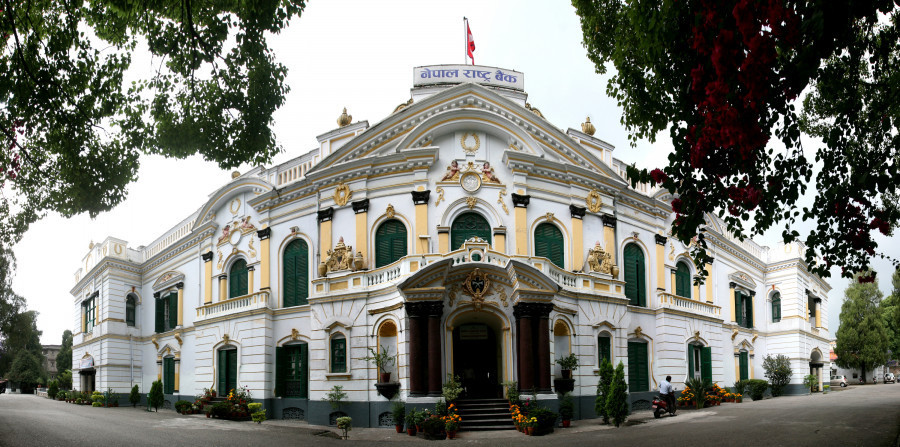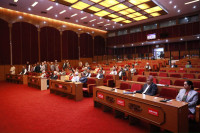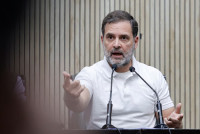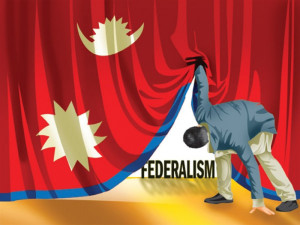Columns
Monitoring monetary policy
Taming inflation will require a coordinated approach between monetary and fiscal policies.
Nischal Dhungel
Almost two months after the Government of Nepal unveiled its fiscal policy for 2023-24, which includes a budget of Rs1.75 trillion, the Nepal Rastra Bank (NRB), on July 23, released its monetary policy for the same fiscal year. The policy aims to support economic recovery, control inflation, stabilise interest rates and ensure credit demand. Nepal experienced a recession until the second quarter of the last fiscal year, leading to a projected annual economic growth of 1.86 percent. Despite the sluggish growth in the past year, the combination of the budget and the recent monetary policy aims to achieve an ambitious growth rate of 6 percent for the current fiscal year.
Monetary indicators
The NRB plans to control inflation by maintaining an accommodative monetary policy. The overall year-on-year consumer price inflation decreased from 8.56 percent in mid-June 2022 to 6.83 percent in mid-June 2023. Despite making profits, the Nepal Oil Corporation (NOC) has decided not to reduce the prices of petroleum products, owing to its outstanding debt. This adds to the burden on consumers, as the high petroleum product costs in Nepal significantly contribute to escalating inflation. In this context, the new monetary policy aims to maintain inflation at 6.5 percent. While the NRB is cautiously optimistic about the inflation trajectory, it remains vigilant about the potential risks that could impact price stability in the future.
The NRB aims to maintain seven months of forex reserves to cover goods and services imports in 2023-24. Based on imports during the 11 months of 2022-23, the banking sector’s forex reserves cover 11.2 months of merchandise imports and 9.6 months of both merchandise and services imports. An import ban was initially implemented to protect dwindling forex reserves, leading to an 11.5 percent increase in reserves when the ban ended. The International Monetary Fund attributes the improvement in forex reserves to monetary policy normalisation. However, import restrictions alone do not address the underlying causes of external pressures, such as persistently high global commodity prices expected in 2023 and robust domestic demand.
Policy rates
The NRB has lowered the policy rate by 50 basis points to 6.5 percent. The policy rate represents the interest rate the NRB charges to commercial banks for overnight loans. Lowering the policy rate is aimed at making borrowing more affordable for businesses and consumers and stimulating economic activity. The bank rate, however, remains unchanged at 7.5 percent. As of November of the fiscal year 2022-23, the average inter-bank rate of banks and financial institutions stood at 6.69 percent, compared to 7 percent a year earlier. Several factors, including the recent decline in inflation, influenced the NRB’s decision. To ensure credit demand, the NRB plans to provide liquidity to banks and financial institutions, reduce the policy rate and increase the lending capacity of banks.
The capital adequacy indicators in Nepal show positive signs for the health of the banking sector as they remain above the minimum requirements. The total average capital-to-risk weighted assets ratio stands at 13.1 percent, surpassing the regulatory minimum of 11 percent. The maximum threshold of 100 percent capital-to-risk weighted assets ratio will be raised to Rs5 million from Rs2.5 million. The deposit collection rate has been lowered to 4.5 percent from 5.5 percent. The Cash Reserve Ratio (CRR) is set at 4 percent, requiring banks to hold that portion of their total deposits as cash reserves with the NRB. The statutory liquidity ratio (SLR) is set at 12 percent for commercial banks, while development banks and finance companies have an SLR of 10 percent. These reserve ratios are essential tools used by the NRB to regulate the money supply, stabilise the financial system and manage inflation by controlling the lending capacity of banks.
On-going concerns
NRB Governor Maha Prasad Adhikari stated that the real sector's growth has not kept up with the rapid credit flow directed towards it. An abrupt slowdown in the share market and the real estate sector caused a credit surge and subsequent bust, impacting borrowers' ability to meet loan and interest obligations and negatively affecting manufacturing, construction and trade. The IMF has expressed concern over significant credit fluctuations in Nepal's financial sector, suggesting that excessive credit expansion and high borrowing rates have reduced borrower repayment capacity. To address the credit concern, the monetary policy states that the NRB will provide clear guidance on loan restructuring and rescheduling for hard-hit sectors and small and medium enterprises facing cash flow crises.
The non-performing loan (NPL) ratio in Nepal, at 2.6 percent, is notably lower than the average NPL ratio of 7.5 percent observed in emerging markets. This suggests that the overall asset quality in the banking sector is considered satisfactory. However, some measures such as classifying overdue loans as "standard" could mask the actual asset quality, and the NPL ratio might be artificially lower. The NRB aims to ensure that banks' loan classification correctly reflects the asset quality of the banking system and will review the loan classification policy, implement Nepal Financial Reporting Standards (NFRS 9) and the expected credit loss model (ECL). Furthermore, the NRB will review the directed lending guidelines and credit concentration to guide BFIs to concentrate on credit management rather than credit creation.
Commendable step
The NRB has taken steps to decrease the number of microfinance institutions through mergers and acquisitions. As of mid-June 2023, 63 microfinance financial institutions are currently in operation. The NRB is committed to establishing a dedicated regulatory body for the cooperative sector, as outlined in the 2023-24 budget. The lack of regulation has resulted in the collapse of cooperatives and increased instances of fraudulent activities. It is necessary to establish a dedicated regulatory body to tackle these issues effectively. The NRB will also implement a centralised “Know Your Customer” (KYC) system, introduce Macro Stress Testing Framework, improve regulatory capacity, enhance the quality of supervision, and upgrade data and regulatory systems to improve its autonomy and accountability framework.
The NRB disclosed its intention to conduct research on the Central Bank Digital Currency (CBDC) in its monetary policy for the fiscal year 2021-22. The central bank has successfully prepared the concept report titled “Central Bank Digital Currency (CBDC): Identifying Suitable Policy Goals and Design for Nepal" to explore the implementation of the CBDC. On the digitalisation front, the NRB recently amended a digital payment licensing policy that will allow non-business businesses like hotels and travel to establish their digital payment system. Moreover, Nepal also inked an agreement with India, China and Sri Lanka for cross-border digital payment. These developments on the digital front facilitate smooth digital payment services inside and outside the country.
The NRB’s monetary policy presents several positive measures, and its effectiveness in implementing these measures will be crucial. Increased foreign reserves due to higher remittances and lower interest rates are gradually making the country's economy vibrant. Lower interest rates can encourage borrowing and investment, potentially impacting consumer spending, business expansion and overall economic growth. The central bank appears mindful of the potential adverse effects of higher interest rates on economic recovery while remaining committed to keeping inflation in check. However, taming inflation will require a coordinated approach between monetary and fiscal policies.




 16.12°C Kathmandu
16.12°C Kathmandu















